Content
- PLI Scheme: Powering India’s Industrial Renaissance
- Pradhan Mantri Matru Vandana Yojana
PLI Scheme: Powering India’s Industrial Renaissance
What is PLI?
- Production Linked Incentive (PLI) Scheme = performance-based incentives given to firms for boosting domestic manufacturing, exports, and job creation.
- Incentives = linked to incremental sales/production, not subsidies upfront.
- Objective = raise India’s manufacturing share of GDP to 25% by 2025–30 (currently ~17%).
Relevance : GS 2(Governance) , GS 3(Manufacturing Sector)
Genesis and Rationale
- India’s economy = services-heavy (50%+ GDP), but manufacturing lagged behind.
- Dependence on imports for electronics, semiconductors, APIs (pharma), and solar weakened strategic autonomy.
- PLI launched in 2020 amid COVID-19 disruptions → to:
- Revive domestic manufacturing.
- Reduce import dependency.
- Strengthen Atmanirbhar Bharat & $5 trillion economy vision.
- Initial launch: mobile phones, electronic components, pharma APIs, medical devices.
- Later expanded → 14 key sectors (electronics, pharma, textiles, auto, semiconductors, food, solar, white goods, etc.).
Scale and Coverage
- Incentive outlay: ₹1.97 lakh crore (over 5 years).
- Applications approved: 806 (as of 2025).
- Committed investments: ₹1.76 lakh crore (Nov 2024).
- Total sales by PLI firms: ₹16.5 lakh crore.
- Jobs created: 12+ lakh (direct + indirect).
- Coverage = 14 strategic sectors → sunrise industries (semiconductors, EVs, solar) + traditional strengths (pharma, textiles).
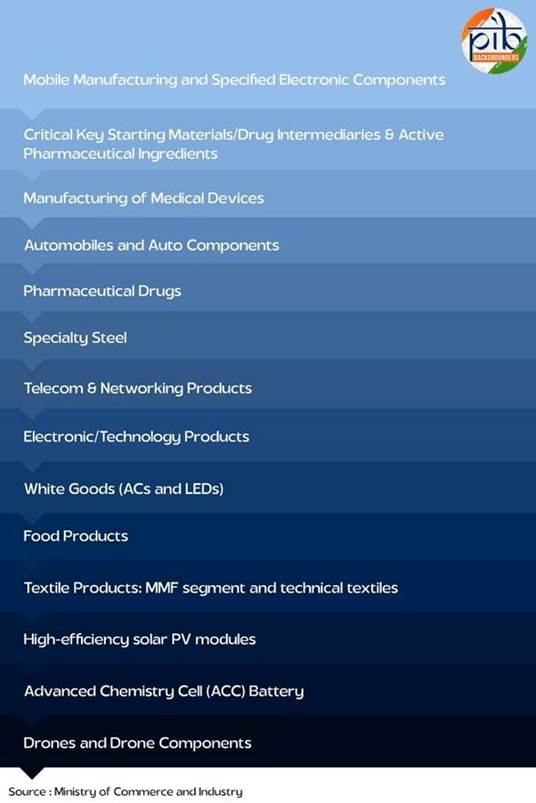
Sectoral Impact
a. Electronics & Mobile Manufacturing
- Production jumped 146% (₹2.13 lakh cr → ₹5.25 lakh cr, FY21–25).
- India = 2nd largest mobile phone producer globally.
- Attracted global OEMs (Apple, Samsung, Foxconn) + Indian firms.
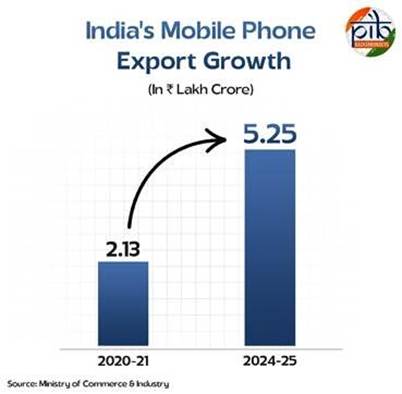
b. Automobiles & EVs
- Investment committed: ₹67,690 cr; invested: ₹14,043 cr.
- Incentives cover 19 categories of EVs & 103 auto-tech components.
- Linked to FAME scheme → EV ecosystem boost.
c. Pharmaceuticals
- Shift from API import dependence to export surplus (₹2,280 cr FY25).
- Pharma sales under PLI (3 yrs): ₹2.66 lakh cr, exports: ₹1.7 lakh cr.
- Domestic value addition: 83.7%.
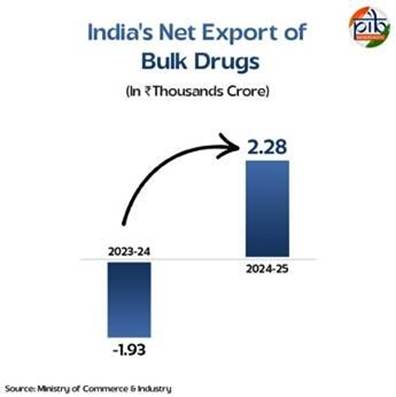
d. Food Processing
- 171 projects approved; investments: ₹8,910 cr.
- Links with PM-FME & PMKSY → value-added exports, modern food branding.
e. Solar PV Modules
- PLI Tranche I & II: 48 GW domestic capacity planned.
- Investment: ₹48,120 cr, jobs: 38,500.
- Import dependence cut, energy security strengthened.
f. Semiconductors
- 6 projects approved + 4 new fabs (Odisha, Punjab, Andhra Pradesh).
- Incentive under India Semiconductor Mission (ISM).
- Job creation: 2,034 skilled professionals (direct), with multiplier effects.
- Goal = self-reliant semiconductor ecosystem by 2030.
g. Textiles (MMF & Technical Textiles)
- Outlay: ₹10,683 cr.
- Exports up: MMF ₹499 → ₹525 cr; Technical textiles ₹200 → ₹294 cr.
- Linked with RoSCTL, RoDTEP schemes for zero-rated exports.
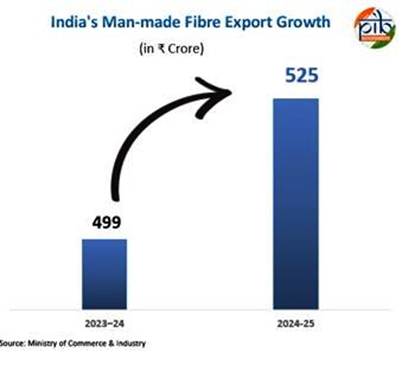
h. White Goods (ACs & LED Lights)
- Outlay: ₹6,238 cr.
- Local value addition to rise from 20–25% → 75–80% by 2028–29.
- Local manufacturing of compressors, motors, LED chip packaging → reduces imports.
Wider Economic Impact
- Job Creation: 12+ lakh (direct + indirect).
- MSME Ripple Effect: anchor firms create supply chains → new MSME vendors.
- Cluster Development:
- Display fabs & semiconductor parks → Gujarat.
- MMF textiles → Surat.
- Medical devices → Andhra Pradesh, Tamil Nadu.
- Exports Boost: Pharma, electronics, textiles → stronger global footprint.
- FDI Push: India emerging as a China+1 manufacturing hub.
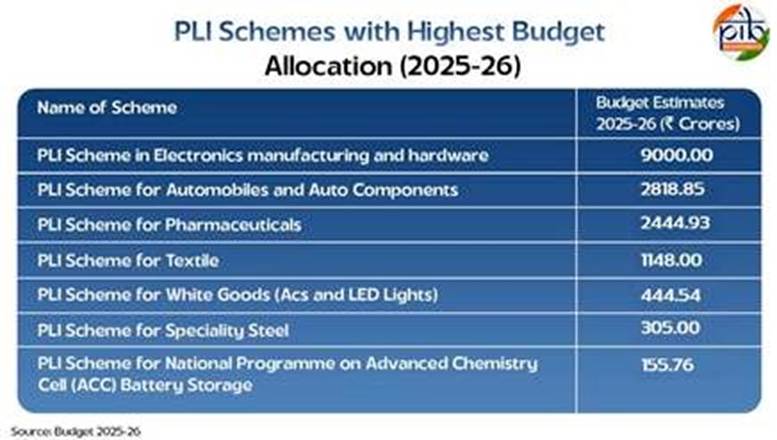
Challenges & Concerns
- Implementation gaps: delays in project execution in some sectors.
- Over-dependence on incentives: risk of industries not sustaining post-PLI.
- Global competitiveness: India must match China, Vietnam, Taiwan in logistics, infrastructure, supply chains.
- Skill shortages: especially in semiconductors, EVs, advanced electronics.
- Budgetary pressure: large incentive outlays require fiscal balance.
Strategic Significance
- Strengthens Atmanirbhar Bharat & resilience in critical supply chains (chips, APIs, solar).
- Aligns with Digital India (electronics, semiconductors), Green India (EVs, solar), Health India (pharma).
- Helps India position as a trusted manufacturing hub amid US-China decoupling.
- Supports $5 trillion economy target and India’s industrial renaissance.
Conclusion
- PLI = more than subsidies → it’s a structural industrial policy tool.
- Demonstrated success in electronics, pharma, solar, textiles, EVs.
- If sustained with infrastructure upgrades, logistics efficiency, skill development, R&D push, India can achieve:
- Global competitiveness in advanced manufacturing.
- Resilient domestic supply chains.
- Inclusive job creation across regions.
Pradhan Mantri Matru Vandana Yojana
Basics
- Launched: 1 January 2017.
- Implementing Ministry: Ministry of Women & Child Development (MWCD).
- Umbrella Scheme: Mission Shakti → under Samarthya sub-scheme for women’s economic empowerment.
- Legal Backing: National Food Security Act (NFSA), 2013 (Section 4 – maternity benefits).
- Type: Conditional cash transfer scheme → to promote rest, nutrition, and institutional delivery.
Relevance : GS 2(Governance , Schemes)
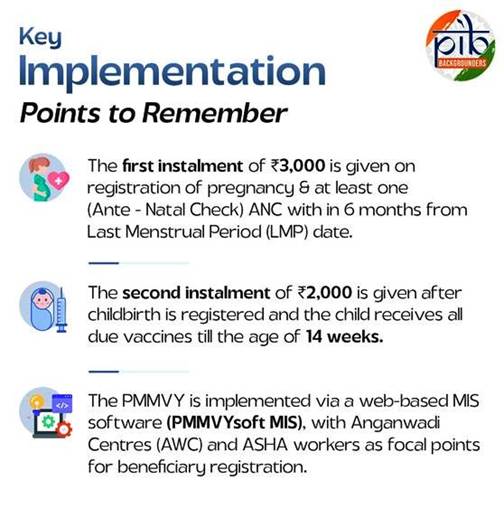
Why Needed?
- High undernutrition burden:
- 1 in 3 women undernourished.
- 1 in 2 women anaemic.
- Maternal-child health link: Undernourished mothers → low birth weight babies → lifelong deficits.
- Work pressure: Women often work till late pregnancy and resume soon after delivery → prevents recovery & exclusive breastfeeding.
- Health-seeking behaviour gap: Low institutional deliveries and ANC (Ante-natal Care) in poor households.
- Social dimension: Son preference and declining Sex Ratio at Birth (SRB).
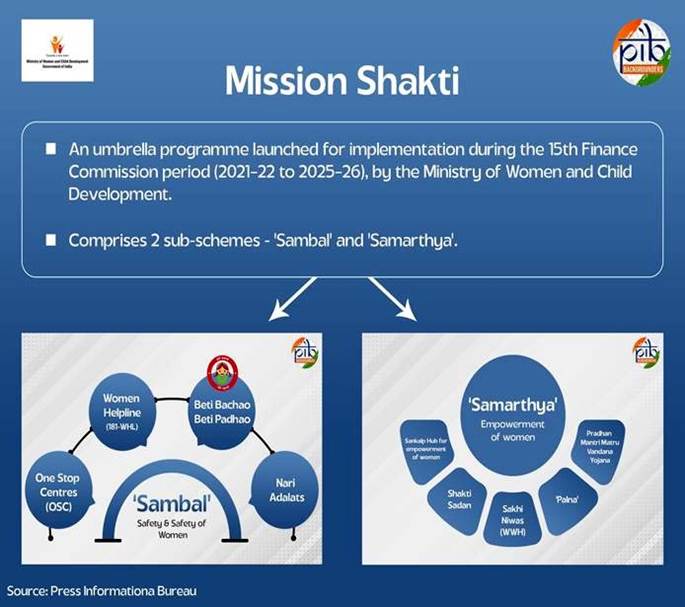
Objectives
- Cash incentive: Partially compensate wage loss → encourage rest pre & post-delivery.
- Health behaviour: Promote ANC check-ups, institutional delivery, exclusive breastfeeding.
- Gender equity: Promote positive attitude towards girl child (incentives for 2nd child if girl).
Key Features
- PMMVY 1.0 (2017–2021): ₹5,000 cash incentive for first living child.
- PMMVY 2.0 (April 2022 onwards):
- ₹5,000 for first child.
- ₹6,000 for second child if girl → incentive for improving SRB.
- Linked with Janani Suraksha Yojana (JSY) → ~₹6,000 total maternity benefit package.
- Target group: Pregnant Women & Lactating Mothers (PW&LM), mainly disadvantaged households.
- Mode of transfer: DBT into Aadhaar-linked bank/post office accounts.
Eligibility & Enrolment
- Beneficiaries: Pregnant women & lactating mothers (except Govt employees).
- Required documents: Mother & Child Protection (MCP) Card + ID + eligibility proof (e.g., BPL card).
- Enrolment modes:
- PMMVY Portal (https://pmmvy.wcd.gov.in).
- UMANG platform.
- Field-level workers: Anganwadi/ASHA via PMMVY App.
Monitoring, Reporting, and Evaluation (Digital Reforms)
- PMMVYSoft (launched March 2023) – end-to-end IT platform for real-time monitoring.
- Real-Time Authentication:
- Aadhaar-based verification (UIDAI + NPCI).
- Biometric (facial recognition) at enrolment → prevents duplication.
- Direct Benefit Transfer (DBT): Seamless transfer to Aadhaar-seeded accounts.
- Transparency & Grievance Redressal:
- Toll-free multilingual helpline (14408).
- SMS alerts (12 languages) at each stage (registration → approval → payment).
- Online grievance module integrated into portal.
- Digital Reporting: Paperless enrolment + mobile app reporting at Anganwadi level.
- Training & Awareness: State-level workshops, YouTube tutorials, IEC campaigns.
- Performance & Impact (till 2025)
- Coverage: Over 3 crore women beneficiaries since 2017.
- Financial transfers: ₹5,000–6,000 per beneficiary → reduced financial stress.
- Health impact:
- Boosted ANC check-ups & institutional deliveries.
- Encouraged exclusive breastfeeding for 6 months.
- Gender impact: PMMVY 2.0 incentivizing girl child births → supports Beti Bachao, Beti Padhao.
- Digital governance: PMMVYSoft improved efficiency, transparency, and fraud prevention.
Challenges & Criticisms
- Limited coverage: Restricted to first child (now 2nd if girl); excludes many mothers.
- Low awareness: Many rural women unaware of scheme or find procedures complex.
- Delayed payments: Despite DBT, fund transfer delays reported in some states.
- Wage loss compensation inadequate: ₹5,000–6,000 far below actual wage loss (~₹15,000–20,000 during maternity).
- State capacity gaps: Dependence on Anganwadi/ASHA workers, who are already overburdened.
Strategic Significance
- Strengthens women-led development under Mission Shakti.
- Supports nutrition and health goals under POSHAN Abhiyaan.
- Contributes to SDG 3 (Health), SDG 5 (Gender Equality), SDG 2 (Zero Hunger).
- Acts as a social security net for poor mothers.
- Links with NFSA 2013 → statutory entitlement dimension.
Conclusion
- PMMVY addresses the intergenerational cycle of malnutrition, ensuring healthier mothers and children.
- With digital reforms (PMMVYSoft, DBT), the scheme has become transparent, scalable, and accountable.
- Yet, to fully empower mothers, coverage expansion, higher benefit amount, and stronger awareness drives are needed.
- PMMVY is not just a cash transfer scheme but a public health and gender equity intervention, shaping future generations.



